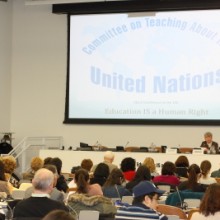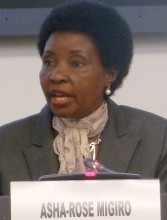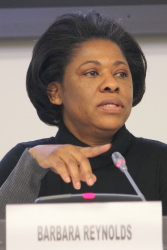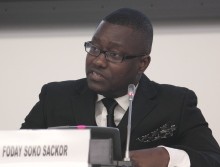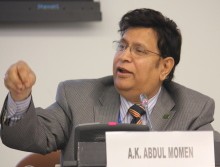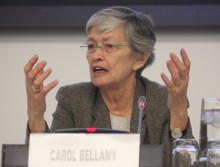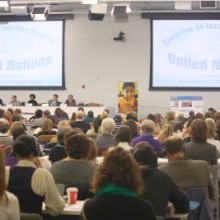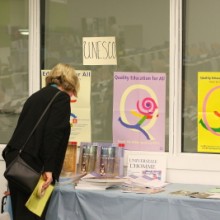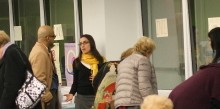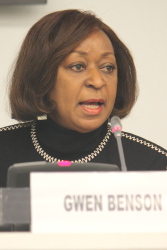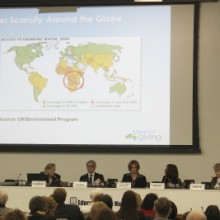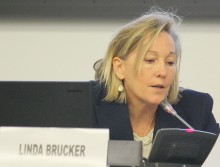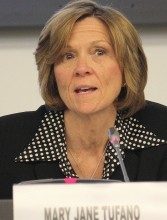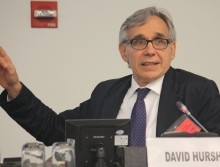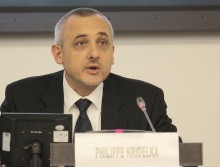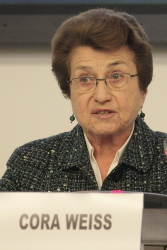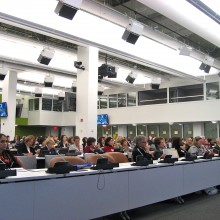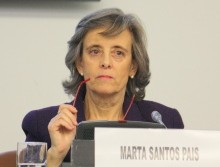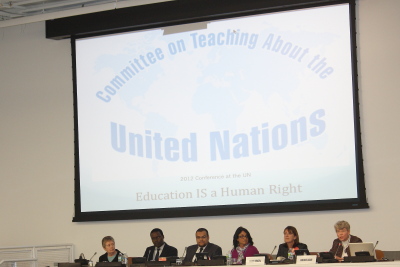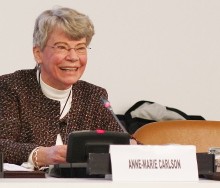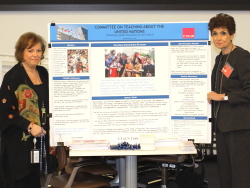2012 UN
13th Annual CTAUN Conference, 3 February 2012 – United Nations, NY
“Education IS a Human Right”
Anne-Marie Carlson, Chair of CTAUN, welcomed all to the North Lawn Building’s ECOSOC (Economic and Social Council) Chamber.
Her opening remarks highlighted the conference focus on the right of everyone to receive an education, including those in the developed West. “The poor, the homeless, the refugee, the migrant, etc. here in North America are entitled to an education along with all those in the most underprivileged areas of Africa and Asia along with Eastern Europe, Latin America, the South Pacific…the list goes on” she said, and encouraged the audience to keep all of them in mind.
Ms. Carlson went on to announce that there were nearly 400 registrants, a very diverse audience: 48 Fulbright scholars representing 33 countries around the world, teachers from Ontario and Quebec, as well as from the US, especially from the Tri-State area. Among the largest groups present were 56 members of The Delta Kappa Gamma Society International and 15 representatives of the American Association of University Women (AAUW).
KEYNOTE ADDRESS – Dr. Asha-Rose Migiro of Tanzania, Deputy Secretary-General of the UN
Dr. Migiro, the first woman to hold that position, has long been a champion of primary education. She spoke about the role of education in traditional societies, where it serves as a means of coping, survival, and initiation into adult roles and their
concomitant responsibilities. She stressed education’s transformative value beyond book learning – teaching people how to conduct themselves, relate to one another and most importantly, to give back to society, and followed by relating how her own education had fostered in her that sense of responsibility toward the international community.
She spoke about her visit to Haiti after the recent earthquake, where, when questioned about what they wanted most, the overwhelming majority of people asked for education for their children. “Education,” she said, “is especially important in the recovery process following a disaster. It keeps children off the streets and fosters a sense of security and a much-needed return to normalcy.” The UN, especially UNICEF, with their “School in a Box” program, does send emergency supplies to disaster areas, as does INEE, the Inter-Agency Network for Education in Emergencies. (See Teacher Resources section for both.) In addition, Dr. Migiro also mentioned a new initiative of Secretary-General Ban Ki Moon – a 5-year action plan to promote education for sustainable development. She closed by saying that the UN can only be successful with the support, initiative and collaboration of civil society.
MORNING PANEL – Access to Quality Education: Removing Barriers and Bottlenecks
Moderator Dr. Barbara Reynolds, a Senior Advisor for Special Projects at UNICEF, began by asking participants what had brought them to the conference. One educator, who had worked in Tanzania, comparing her experience there with that in the US, responded that challenges to education here are equally compelling. Dr. Reynolds agreed that developed countries face challenges, especially with regard to migrant populations, and suggested that there are things to be learned on both sides. She applauded the work of CTAUN and progress at the university level, but felt it important that the UN play a role in creating more openness in the broader society.
Following Dr. Migiro’s lead, she stressed the importance of partnerships based on trust. How do we work together to get the world’s 68 million children who are out of school back where they need to be, tuned in and turned on? She then set the tone for the morning panel: in the past we have focused on access – just going by the numbers, it was felt that education for all was nearer to reality than it had been. But access alone is not enough – we have to start thinking of what constitutes quality in education. There is no single methodology – what makes for quality varies with the needs of each community and culture.
Foday Soko Sackor, a Liberian refugee and candidate for a Master’s Degree in International Affairs at Columbia University, asked us to imagine a continent where 41% of children under the age of 15 can read, but fully half of women over age 25 are illiterate. He concurred with former Secretary-General Kofi Annan who has said, “When you educate a man, you educate an individual; when you educate a woman you educate a family.”
He spoke movingly of the sounds of war terrorizing children in classrooms and of his own experiences as such a child, where the infrastructure of schools vanishes, morale is crushed and school loses its soul. In addition, 20% of children are AIDS orphans, and AIDS has also claimed the lives of 10% of their teachers. Twenty million more teachers are needed for Africa alone. Poverty is also a factor, since the need for food takes precedence over education, and families often take their children out of school to scavenge. Yet education is the single most important tool for overcoming poverty. Under these circumstances, he is pessimistic that Millennium Development Goal #2 of universal primary education can be reached by 2015.
In recent years, a number of countries in Africa, including Ghana, Uganda, Kenya, Tanzania, Burundi, the Democratic Republic of Congo and Malawi have eliminated fees for public education. School enrollment has surged. In Kenya alone attendance grew from 1.2 million in 2003 to 7.2 million in 2004, and 84% are in primary school. But this has brought about incredible challenges. Classes are vastly overcrowded, children are taught by rote, and teachers are undertrained. Yet governments continue to focus on quantity rather than quality.
There is no effort to bring creativity or relevance into the curriculum. As a result, students who can find employment are working in jobs that don’t interest them. To Mr. Sackor, the root cause of lack of jobs is that educators are teaching the wrong things. “What is the target?” “What is being taught and how is it being taught?” are the questions which demand attention. There should be an outcome-based approach to teacher training, including critical thinking and problem-solving skills, and application of knowledge to real situations. Since cellular technology is readily available, readings could be put on cell phones. Quality presents opportunity, especially in science, math and technology. Other solutions he offered included:
- Free transportation, texts and meals to schoolchildren
- Cash transfers to poor families if they send girls to school
- Investment in computers and research
- Empowering a culture of readers and writers at an early age
- More resources for career guidance and
- Raising domestic spending on education to 15-20%
Dr. A.K. Abdul Momen, Ambassador to the UN from Bangladesh, spoke about bottlenecks from the government perspective. Resources are constrained in Bangladesh for three basic reasons:
1) There are 150 million people in Bangladesh, and the government can provide for less than 4%. What is provided is underutilized, and the schools themselves are unequally distributed around the country. Some are too far away for children to attend daily. In one island area of 50 rural families, much of the land is underwater for 8 months of the year during monsoon season. Parents are afraid to send their daughters to school, among other reasons, due to the likely presence of snakes.
2) There are no trained teachers to use the resources, and, as there is no pay incentive for teachers, 2 out of 3 drop out. In addition there are no free lunches, and children, lacking nutrition and unable to focus, go home. The UN World Food Program (WFP) and UNICEF are helping in this area, but provide less than 20% of what’s needed.
3) Funding for schools in Bangladesh comes largely from the private sector. There is no global political will to make education a priority. In 2010 the equivalent of $112 trillion was spent on defense, including $120 billion to maintain security in Afghanistan, whereas only $2 billion, of the $16 billion needed, was allotted to education. Opportunity costs. Families who send girls to school in Bangladesh receive $1.20 a month from the government, provided the girls don’t marry before the age of 18, keep up an average grade of 75, and have an attendance rate of 75 %. 51% of primary age girls are in school, and 55% of teens. 4 % of Bangladesh’s children are educated in the US.
Dr. Momen believes that there must be public advocacy for greater education funding, and that the overall mindset concerning the need for and value of education must be changed. Case-study research shows that education raises income levels by 10% and improves health care by 68%.
Carol Bellamy, Chair of the Global Partnership for Education, followed up on Dr. Momen’s comments on government support for education. She reminded us there has been progress over the last 20 years. In 2000, there were 100 million children who had no access to schooling. By 2012, that number has dropped to 67million. The gap between male and female in Kenya has been closing at the primary level. In Bangladesh, this is also true at the secondary level.
But, as she put it, “the goalposts have shifted,” and developed donor countries like Denmark and the Netherlands don’t see the progress. They see the problem as intractable, and consequently, have been pulling back from education in favor of other priorities. Most funding comes from within – from the governments of the countries themselves, where education as a human right is a law, but not a norm.
Ms. Bellamy also concurred with the other speakers on the panel in their emphasis on quality in education, as opposed to simply access. Although there is a lot of focus on reading, there is increasing use of hand-held technology. Even teachers in rural areas, who once had to travel long distances to cities to receive pay, can now access their salaries through their cell phones. She deplored the policy of some US districts of removing the arts from the curriculum whenever funds are low. “That is not good for creating a humane system,” she said.
In the Q&A that followed, Ms. Bellamy was asked if the UN had the power to intervene and alter curriculum in a country when it isn’t working. “No,” she said. “Good policy dialogues can certainly contribute, but the UN can’t parachute policy into a country. Education must be anchored in each country. But if there is a global consciousness, it will translate into local policy.”
Dr. Momen added that in Bangladesh, local governments followed the directive of the international community – first, to increase enrollment, then to attend to gender in enrollment. But national governments need monitoring.
We hear most about trafficking in girls, but 15,000 boys have been trafficked as well. Using her own funds, plus $8500 raised by students washing cars on Cape Cod, Ms. Bellamy has contributed to rescue efforts. “Children in conflict need immediate international support,” she said, “in morale boosting, mentoring, access to psychologists, etc. from all levels of society. The international community has dropped the ball on education in conflict situations. They concentrate on health. But education brings a return to sanity and normalcy for those children. Conflicts can go on for years, and a whole generation can go without education.” 40% of Africa is currently in conflict.
Natural disasters, as well as conflicts, degenerate societies; building back should be better. Dr. Reynolds closed the morning panel by talking about how seed money can motivate governments to pick up the ball. She cited the example of UNICEF enabling pregnant women in China to get into clinics, thus producing healthier babies. This policy was then replicated by local governments around the country.
SPOTLIGHT 1
– Meg Gardinier, founding member and current Chair of Chair of the US Campaign to Ratify the Convention on the Rights of the Child – introduced by Grace Murphy, CTAUN Vice-Chair
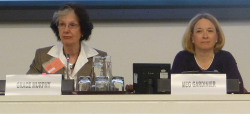
CTAUN Vice Chair Grace Murphy introduced Meg Gardinier, Chair of the US Campaign for the Ratification of the CRC
Ms. Gardinier explained that The Convention on the Rights of the Child (CRC) was adopted by the UN General Assembly on November 20, 1989, Universal Children’s Day. At this point only 3 countries — Somalia, South Sudan and the US — have yet to ratify it. The United States played a pivotal role in the drafting of the RC between 1979 and 1989 when the treaty was adopted by the General Assembly. Specifically, the Reagan and George H.W. Bush Administrations actively contributed to negotiating the treaty’s text. The US submitted proposals that establish a child’s right to freedom of expression, freedom of religion, freedom of association and assembly. So it seems ironic that today’s conservatives have turned these positives into negatives, believing that ratifying a UN treaty would compromise US sovereignty, and that it would cause cultural permissiveness. Many who vetoed the CRC had never, in fact, read the document.
Ms. Gardinier urged all attendees at our conference to read the treaty themselves, and to sign a petition asking President Obama to re-submit the CRC to the US Senate by Presidents’ Day, as a way of honoring those presidents who contributed to and supported it. Though ratification by November 20 of this year is the goal, Ms. Gardinier cautioned that many treaties have taken years before being ratified. It took 17 years for the Treaty on Genocide to be accepted by the US Senate, but in the end, it was successful. So persistence works. Ms. Gardinier encouraged everyone to sign the petition at www.childrightscampaign.org.
BEST PRACTICES AWARD
Dr. Jacqueline Abbott, CTAUN’s Best Practices Chair, presented this year’s award to Joan Monk and Cecilia Dinio-Durkin of the Poughkeepsie branch of AAUW (the American Association of University Women). Melissa Guardaro accepted the award on behalf of Joan Monk, who was unable to be present.
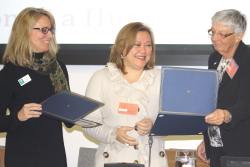
CTAUN Best Practices Award Chair Dr. Jacqueline Abbott honoring the winners: representatives from AAUW Poughkeepsie Branch
Inspired by the book Half the Sky by Nicholas Kristof and Sheryl WuDunn, featured at the 2011 CTAUN conference, (see Conference Report for 2011), the winning project is entitled “My Sister’s Keeper” (MSK). Its aim is to turn women’s concerns into venues for local and international action. Partnership with like-minded organizations, raising the visibility of AAUW, and support for the UN’s Millennium Development Goals are also key elements.
Implementation included the following:
1) Poughkeepsie members and book groups read and discussed Half the Sky to educate themselves about the issues.
2) An action committee was formed, which focused on 5 areas:
- Violence Against Women
- Gender Equality
- Women’s and Girls’ Education
- Maternal Health Care
- Economic Empowerment
3) Publicity materials were created and members were encouraged to take action both personally and within their families.
4) Members attended events such as MSK Marketplace, International Women’s Day, where they did a Walk Across the Hudson, and Fair Trade Day. Ms. Dinio-Durkin owns a Fair Trade shop that sells products made by indigenous women. Last year they sold 500 bags, each providing a day’s wage for a woman in Africa.
5) MSK supported a student through Beads for Education, raised money for the Heifer Project, contributed to the Fistula Foundation, and supported Kiva (which supports income generation for women in Africa). They also adopted causes such as a library in Madagascar and the building of a school in Liberia.
As their Year One project proved to be a great success, they hope to continue into 2012-13. For more information see www.aauwpoughkeepsie.org/index.php?page=my_sisters_keeper.
LUNCH and the CTAUN INFO FAIR
chaired by Ruth Nielsen, followed. InfoFair participants included the following:
From the UN: Office of the Special Representative for Children and Armed Conflict; UNICEF; UNICEF, USA; UN Population Fund; UNESCO.
From the Private Sector: Asia Society; Celebration of Teaching and Learning, WNET; Girls Learn International, Inc.; Global Education Motivators; Global Teaching and Learning Project; INEE; Legacy of Giving; NYU Center for Global Affairs; The Peace Corps;US Campaign to Ratify the Convention on the Rights of the Child
SPOTLIGHT 2
– The video – “BiblioBurro Mobile Four Legged Library: Colombia” – could not be shown due to technical difficulties, but can be seen at www.youtube.com — search “biblioburro” and scroll to the above title to meet teacher Luis Soriano.
AFTERNOON PANEL – Taking the Global Pulse of Education: Current and Emerging Agents of Change
Moderator Dr. Gwen Benson, Associate Dean of the College of Education at Georgia State University, set the tone for the afternoon panel by picking up on the morning’s challenges with workable solutions. “We must consider how to move our heartfelt passion into workable action,” she said.
She then spoke about the Professional Development Model used at Georgia State with exchange students and GSU’s commitment to South Africa, Brazil, Turkey, China and Korea. Many countries have mandated that their universities serve as leaders of change in expediting the development of educational capacity for children and adolescents. For many universities, active involvement has been challenging. No template for such work exists. For this reason, GSU is bringing together educational leaders from around the world to take up the issue in a conference called “Blurring the Boundaries” on April 10th in Atlanta, to which CTAUN will also be a contributor.
Linda Brucker – Founder and Executive Director of “A Legacy of Giving,” she began with a quote from former Secretary-General Kofi Annan: “Education is a human right with an immense power to transform.” She then shared her own personal transformation from marketing executive to her present work, when her son brought home a philanthropy project from the Austin, TX public schools.
She made the distinction between giving for the short term and giving for sustainability, and is a firm believer that philanthropy needs to be taught. After considerable research, finding that no Service Learning curriculum existed, she decided to develop one herself. Based on the theories of Carl Jung, and believing, with Aristotle, that learning to make wise choices is not easy, so it’s best to start young, Legacy works with children as early as first grade. Principal focus is on grades 5-12, with professional development for teachers included.
Children are taught to recognize their own talents and to share them: Time +Talent = Treasure. Legacy’s two-pronged units, one each semester, target poverty and water scarcity, and have been integrated into Texas State Standards. The model is a 5-step process that includes
1) Learning – What is Philanthropy? Why do it? and the issues involved – through academic assemblies
2) Internalizing – through ‘Make-it-your-own’ follow up lessons
3) Advocating – through advocacy lessons for teachers, developed by Legacy educators
4) Acting – through Day of Service and Walk for the Water
5) Reflecting – through teacher reflection lessons, developed by Legacy educators
Ms. Brucker shared a visual presentation to illustrate how philanthropy education can be integrated into the Social Studies curriculum. She used a chart of 200 glasses of water to represent the Earth’s 75% water composition, only 1 glass of which is potable, and told us that in the US, 28 5-gallon buckets of water are used per person daily, while in Ethiopia, ½ bucket is available for daily use. She also used the voice and photos of NY philanthropist Teddy Roosevelt to encourage environmental conservation, especially as applied to water. One of the activities in the water unit involves students walking 3.7 miles, the average it takes to locate a water source in Africa. Funds raised from this activity will be used to build a well in Burundi.
She ended with a short video of young children who see themselves as philanthropists, and a quote from Winston Churchill: “You make a living by what you get; you make a life by what you give.”
Mary Jane Tufano – A teacher with the NY City Department of Education for 33 years, with an expertise in Technology, she listed some of the components of education in Finland, which has the highest scores in the world.
- All children are given equal education.
- There is less emphasis on homework, more on creative play.
- Emphasis is on process as well as product.
- All schools are public.
- There is greater emphasis on responsibility, less on accountability.
- Tests are self-created rather than from an external source.
- Administrators and teachers are valued and well paid.
- Competition is non-existent –“Real winners don’t compete,” they collaborate.
- Classrooms must reflect the world and the interconnected global society.
Ms. Tufano then spoke about the uses of technology in the classroom, and believes it is not being used as successfully as it could be. Teachers need training in how to integrate technology successfully. Using ‘techies’ to teach isn’t always successful. Today’s teaching is largely robotic; the hierarchy has made changes that focus solely on academics and test scores for the purpose of rating schools. The missing piece is trust in teachers.
Technology can shift the focus and can make students excited about learning. Children who have ownership of a topic don’t forget it so easily. When they find a topic themselves, as opposed to being directed, they own it and take charge. In her school, each child in grades 2-8 has a laptop. Topics they have investigated include childhood obesity and Plumpy Nut (a supplement that jumpstarts nutrition in starving babies – a child dies of starvation every ½ hour, and even in the US 1 in 7 children goes to bed hungry), child labor laws in China, and child soldiers.
She shared a number of technology sites:
www.imbee.com teaches students to use social networking safely (a no-bullying zone).
www.tpck.org attempts to define the nature of knowledge teachers need in order to integrate technology into their teaching. They start with a Venn diagram where Technology, Pedagogy and Content intersect, creating a framework of 3 types of knowledge: Technology + Pedagogy, Technology + Content, and Content + Pedagogy.
www.ePals.com is a social network for the K-12 classroom that enables teachers and students to connect with the Global Community.
www.kidlink.org is a Swedish network that promotes dialogue among youth and enables teachers to carry out projects collaboratively.
www.portaportal.com teaches math skills through games to elementary and middle school students. It is aligned with standards in several states.
In the Q&A that followed, a registrant asked about the dangers of overuse of Social Media. Ms. Tufano replied that in the NY City system, there are strong strictures against using Facebook during school hours.
Dr. David Hursh – An Associate Professor on leave from the University of Rochester’s Warner Graduate School of Education, he is a visiting research scholar at the Earth Institute at Columbia University. He began by talking about the politics of high stakes testing in Africa. He then spoke about the Millennium Villages Project, a 10-year effort, which is halfway toward achieving the MDGs in Ethiopia, Ghana, Kenya, Rwanda, Nigeria, Malawi, Mali, Tanzania and Senegal. He believes that attacking one sector of the MDGs has a synergistic effect on the others, so they attempt to work on all the MDGs simultaneously.
Another initiative of Columbia’s Earth Institute is Connect to Learn: Educate a Girl. Change the World. The program focuses primarily on girls’ education, but through partnerships with other organizations, offers secondary school scholarships for both boys and girls, implements mobile broadband technology to connect their classrooms to a 21st Century education, and supports the establishment of a Global Fund for Education. www.connecttolearn.org.
Dr. Hursh mentioned two books: The Price of Civilization by Jeffrey Sachs and his own Teaching Environmental Health to Children: An Interdisciplinary Approach. He spoke about social justice through environmental education and the toxins and diseases caused by heavy metals, pet waste and herbicides. Two million have died as well from the deleterious effects of wood cookstoves.
DIALOGUE
was facilitated by Philippe Kridelka, Director of the NY Office of UNESCO (the United Nations Educational, Scientific and Cultural Organization).
Mr. Kridelka stated that the human right to education has been enshrined not only in the Universal Declaration of Human Rights, but also in the International Covenant on Economic, Social and Cultural Rights and the UNESCO Convention Against Discrimination in Education.
“Education is the bricks and mortar of human dignity,” he said. This is the vision that underpins the ‘Education for All’ goals adopted at the World Education Forum in Dakar, Senegal in 2000. UNESCO is leading the movement by coordinating the “E6” meetings of those agencies most concerned with Education for All – UNESCO, UNICEF, UNDP (UN Development Programme), the World Bank, UNFPA (the UN Population Fund), and the Global Partnership for Education, with UN Women regularly invited to attend.
He concurred with Dr. Momen that one extra year of education can increase an individual’s earnings up to 10% and average annual GDP by .37%. 17 million people could be lifted out of poverty if students in low-income countries left school with basic reading skills, creating a 12% cut in world poverty.
Believing that “children are not born with hatred…they are taught to hate,” he then highlighted three current initiatives of UNESCO to address this problem:
- Damage and needs assessments of educational institutions have been crucial in disaster areas like Haiti, where 450,000 children were displaced after the 2010 earthquake. An emergency curriculum was developed, and, with its partners, UNESCO trained over 3000 secondary teachers in learner-centered psychological support. They launched a nation-wide census of all technical and vocational centers, and the first five have now been reconstructed and equipped.
- Youth education programs, curriculum design and teacher training have been effective in the fight against Holocaust denial, and as part of a platform to access resources for Holocaust Remembrance.
- Launched on January 18, 2012, with the US and Brazil, the “Teaching Respect for All” program aims to build tolerance within schools and the greater community. This curriculum will be developed over the next two years, and will be disseminated worldwide through education ministries and the 9000 UNESCO associated schools.
Cora Weiss – President of The Hague Appeal for Peace, she is a passionate advocate for peace education, for reissuing the goal of a Global Campaign for Peace Education and a National Peace Academy. Peace studies should be at the heart of what we do – peace is not an extra course; “www” she added, “stands for World Without War.”
She quoted directly from Article 26 of the Universal Declaration of Human Rights:
- Everyone shall have the right to education. Education shall be free, at least at the elementary and fundamental stages. Elementary education shall be compulsory. Technical and professional education shall be made generally available and higher education shall be equally accessible to all on the basis of merit.
- Education shall be directed to the full development of the human personality and to the strengthening of human rights and fundamental freedoms. It shall promote understanding, friendship and tolerance among nations, racial or religious groups, and shall further the activities of the United Nations for the maintenance of peace.
- Parents shall have a prior right to choose the kind of education that shall be given to their children.
Ms. Weiss said that when Article 26 is fully implemented, teachers will be the most important people in the world. “To reach peace, teach peace,” she added. Peace education should be part of the curriculum in teacher training colleges. “We cannot afford war. If wars were not profitable, they wouldn’t exist.”
She mentioned Victor Hugo, who said in 1849, “One day the battlefield will be the marketplace, where bullets will be replaced by votes.” A well-educated society teaches critical thinking skills and independent thinking from pre-kindergarten throughout life, to equip citizens to participate in government. She went beyond the 3 R’s to a 4th, which stands for reconciliation.
In response to a Q&A “What is your office doing?” she responded, “Educating the ‘dips’ (diplomats). We need to educate parliaments who have the power of the purse.” In response to another question, she mentioned several challenges:
- Communities cannot exist on cuts to education.
- We need educators, not business people, to administer our schools.
- Fundamentalist religions are playing havoc with education.
- Pregnancy and early marriage put girls out of the education system.
- Non-English speakers can’t get scholarships.
- How do we teach peace in Palestine?“
Ms. Weiss ended by recommending that we all take the time to read the Universal Declaration of Human Rights, the Charter of the United Nations, and the Agenda of the Hague Appeal for Peace. She also provided the following list of useful resources:
— www.peace-ed-campaign.org Global Campaign for Peace Education
— www.haguepeace.org Hague Appeal for Peace
— www.haguepeace.org Hague Agenda for Peace and Justice for the 21st Century:
— www.i-i-p-e.org International Institute for Peace Education: Summer institute for educators in Japan in 2012
— www.scribd.com/collections/2700158/Peace-Education Teachers Without Borders: (k-12 course on peace education)
— info@icanw.org Learn Peace, How students can rid the world of nuclear weapons: — (43 page booklet on disarmament education from ICAN, Int’l Campaign to Abolish Nuclear Weapons, Carlton, Vic, Australia )
— www.endchildsoldiering.org Peace Education and Guidance Counseling in Northern Uganda, UMECS, United Movement to End Child Soldiering
— www.nonviolentpeaceforce.org Non Violent Peace Force
— www.unwomen.org UN Women
— www.peacewomen.org UN SC Res. 1325 on Women, Peace and Security in over 100 languages
— http://decade-culture-of-peace.org Culture of Peace
Charter of the United Nations Article 25 – Members agree to carry out the decisions of the Security Council
Marta Santos Pais – The Special Representative of the Secretary General on Violence Against Children, began by saying “Everyone has the right to grow, without being endangered on the way to school.” Her goal is to raise public awareness of what she terms the “silent abuse” in school systems such as:
— Beating children behind closed doors in the classroom
— Sex for grades
— Bullying and gangs
— Police invading schools
— Rape on the way to school
— Rejection by teachers because of racial or religious differences
These are common practices, or at least not forbidden, in 80 countries. They are also difficult to change, as parents are frightened of speaking up against authority and seldom complain.
Ms. Pais mentioned Belize as the first Caribbean state to ban corporal punishment. Yet even there, the idea was difficult to promote, as parents and teachers felt that without the use of force their authority would be undermined. Violence is perpetrated against boys as well as against girls.
SPECIAL FEATURE – INSPIRATIONS (audience participation)
was introduced by Eileen Venezia, CTAUN member and former recipient of our Best Practices Award.
The following registrants were chosen to share their inspirations from the conference based on their experiences and work.
Bhavani Parpia – A Texas educator from India, she took students on a Fulbright to visit rural schools in India. Realizing that the level of teacher training in India was poor, on her return she started a professional development non-profit called ‘Connect Teach’ www.facebook.com/connectteach.
Mohamed Abdel – A Fulbright student from Egypt, he teaches Arabic at SUNY Cobleskill in upstate NY. His goal is promoting mutual understanding outside of the classroom.
Kevin Murungi – A Kenyan national and human rights and policy specialist at Global Kids www.globalkids.org, he took 20 US youths to Kenya to connect with 20 Kenyans on social media projects. He spoke to the fact that we all acknowledge the importance of education, yet the international community undervalues teachers. The issue was how to use the MDGs to bridge the disconnect.
Pat Bartoshesky – A retired school librarian, she believes that mediocre teachers should not be discarded, but can be re-educated and re-inspired. Education needs to be as smart and appealing as Madison Avenue. Students will go all out when they’re motivated. Her effort was selling candy to raise money for UNICEF.
CLOSING
– Anne-Marie Carlson closed the conference by thanking participants for coming and reminding them of future CTAUN conferences:
“Water: Global and Local Challenges,” Atlanta, March 17;
“Blurring the Boundaries,” Atlanta, April 10, and
“Undoing Intolerance: Solutions for Change,” Austin, September 22.
Check the Home Page on our website for more details. Also click on Teacher Resources for practical materials to facilitate teaching the topics of CTAUN conferences, including websites referred to by speakers and InfoFair exhibitors.
Written by Toni Giangrande with gratitude for their assistance to the following:
Nancy Brown, Joan Bruner-Timmons, Christina Ferrari, Peggy Kelland, Julie Kleszczewski, Mary Lee Kortes, Peggy Montgomery, Lochie Musso, Holly Shaw, and Eileen Venezia.
Photos courtesy of Don Carlson.
Conference Statement
The United Nations first articulated the right to education in the 1948 Universal Declaration of Human Rights. Article 28 stipulates that everyone has the right to a free and compulsory elementary education, with technical, professional and higher education “equally accessible to all on the basis of merit.” The purpose of education is to promote the “full development of the human personality” and to strengthen “respect for human rights and fundamental freedoms.”
Over the last 63 years, many international covenants, conventions, treaties, declarations, conferences, plans of action, and reports have built upon this base to assure that governments commit to and meet their obligations to realizing the human right to education. The Convention on the Rights of the Child (1989), for example, makes explicit how the right applies to children and their parents, and UNESCO’s 1990 World Declaration on Education for All re-emphasizes that every person must be educated “to develop their full capacities, to live and work in dignity.”
Yet, worldwide today, it is estimated that 69 million children are not in school and approximately one adult in six is unable to read or write. Two out of three illiterate adults are women.
Our Conference this year investigated the many causes of this disparity between the stated goals and the actualities of the human right to education for so many children and adults around the world. We focused on how access to and quality of education, seen by some as two sides of the same coin, can steadily improve the educational experience for all learners.
If you are planning for tomorrow, sow rice; if you are planning for a decade,
plant trees; if you are planning for a lifetime, educate people.
~ Chinese proverb

